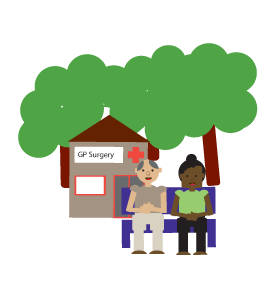- Living well at home
- Regaining independence
Buurtzorg Britain & Ireland A pioneering approach to delivering health and social care
Organisation
Buurtzorg Britain & Ireland is a partnership of two social enterprises, Buurtzorg in the Netherlands and Public World in Britain and Ireland. It provides consultancy and learning and development services to public and third sector organisations to support the creation of better services, jobs and organisational performance through self-managed team work and workforce and community involvement. We bring the revolutionary Dutch Buurtzorg model to Britain and Ireland, working with care providers and commissioners to enable the transition to self-managed neighbourhood teams providing holistic care and the organisational changes needed to support them.
What is the problem this innovation solves?
Community health and social care is provided in a fragmented way, in which patients are being done unto, and care professionals are disempowered. With continuously increasing healthcare costs and an ageing population, a radical solution is needed that supports care in the community based on prevention and early intervention, building on community assets and encouraging patients' self-reliance and independence.
Solution
The Buurtzorg model involves care being delivered in a holistic, integrated fashion, through small, local, self-managing teams of empowered professionals, supported by coaches and a small back office.
We work with a range of NHS organisations, local authorities and others on the adoption of the model into the local UK context through so-called Test & Learns. These are small set-ups through which to find local solutions to hurdles encountered before rollout to the wider organisation(s).
Evidence base
Buurtzorg Netherlands grew from a start-up in 2007 to nearly 1,000 teams of more than 10,000 care professionals looking after 80,000 clients today, and is currently the Netherlands' market leader in home care.
Independent studies have shown that its care model results in 40% lower care costs, its service is rated highest by clients of all care providers, it has been awarded Employer of the Year for 4 times out of the past 7 years and in 2019 it received highest-ever marks from the Care Regulator.
Initiatives in the UK to date have been subject to independent evaluations, and have shown similar achievements regarding patient and employee satisfaction, and encouraging results in terms of cost levels. However, implementations on a larger scale will be required to provide further evidence of true financial and outcome improvements.
Expected impact
Adoption of the Buurtzorg model in various contexts is expected to lead to people living longer and better lives in their own homes. It will also provide more fulfilling jobs for professionals currently under significant pressure, as well as the return from disenfranchised carers to the profession.
Stage/spread
Currently between 15 and 20 teams are in Test & Learn stages throughout the UK, involving a similar number of public sector organisations and social enterprises.
In the Netherlands, Buurtzorg provides community care through 1,000 teams of between 8 and 12 professionals, to 80,000 patients annually.
What would councils/health organisations/local areas need to do or have in place to enable it to develop?
- Get their heads around the Buurtzorg CARE model as well as the organisational model: this is not just about self-managing teams / no managers. This is first and foremost about a different outlook on what good care looks like, with particular emphasis on supporting quality of life at home and building caring neighbourhoods.
- A full understanding is required that this involves organisational change, not just front-line change.
- Full and visible buy-in is required from senior executives and politicians.
- This requires trust in the professional: a move away from time and task and into relationship-based care.
- A relentless drive for simplification and reducing bureaucracy.
What would kill it?
Trying to make the model fit the system, rather than the system fit the model.
Where to go for more information
- www.buurtzorg.org.uk (opens new window)
- admin@publicworld.org
- 020 3092 4789

